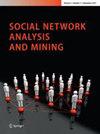COVID-19如何影响用户在twitter上与在线流媒体服务提供商的互动
IF 2.3
Q3 COMPUTER SCIENCE, INFORMATION SYSTEMS
引用次数: 0
摘要
2019冠状病毒病(COVID-19)于2020年3月宣布大流行,在全球范围内蔓延,导致人们的生活方式和行为发生了重大变化,特别是在媒体和娱乐消费方面。事实上,在此期间,在线流媒体平台已成为娱乐内容的首选提供商,而在线社交网络被证明是在坚持保持距离的情况下寻找社交关系的最佳场所。与此同时,从在线流媒体服务提供商的角度来看,在线社交网络作为商业智能的宝贵数据源和连接和共同观看平台的重要性越来越大。本研究从这些考虑出发,探讨COVID-19对在线社交网络中用户与流媒体服务提供商互动的影响。我们的调查重点是Twitter平台;通过比较不同时期(即COVID-19出现之前、期间和之后)的几个大型数据集,我们利用自然语言处理和情感分析技术研究了有趣的模式和动态。我们的数据科学活动,以及得出的主要发现,采用了一种特殊的视角,专注于不同类别的用户和流媒体服务提供商。分析的主要目的是揭示COVID-19疫情期间人与企业之间互动演变的动态。本文章由计算机程序翻译,如有差异,请以英文原文为准。
How COVID-19 affects user interaction with online streaming service providers on twitter
Abstract The worldwide diffusion of COVID-19, declared pandemic in March 2020, has led to significant changes in people’s lifestyles and behavior, especially when it comes to the consumption of media and entertainment. Indeed, during this period, online streaming platforms have become the preferred providers of recreational content, whereas Online Social Networks proved to be the favorite place to find social connections while adhering to distancing measures. In the meantime, from the online Streaming Service Providers’ point of view, Online Social Networks have gained more and more importance both as valuable data sources for business intelligence and as connected and co-viewing platforms. This study starts from these considerations to explore the impact of COVID-19 on user interaction with Streaming Service Providers in Online Social Networks. In particular, our investigation focuses on the Twitter platform; by comparing several large datasets referring to different periods (i.e., before, during, and after COVID-19 emergence), we investigate interesting patterns and dynamics leveraging both Natural Language Processing and sentiment analysis techniques. Our data science campaign, and the main findings derived, adopts a peculiar perspective focusing on the different categories of users and Streaming Service Providers. The main objective of the analysis is to uncover the dynamics underlying the evolution of the interaction between people and businesses during the COVID-19 outbreak.
求助全文
通过发布文献求助,成功后即可免费获取论文全文。
去求助
来源期刊

Social Network Analysis and Mining
COMPUTER SCIENCE, INFORMATION SYSTEMS-
CiteScore
5.70
自引率
14.30%
发文量
141
期刊介绍:
Social Network Analysis and Mining (SNAM) is a multidisciplinary journal serving researchers and practitioners in academia and industry. It is the main venue for a wide range of researchers and readers from computer science, network science, social sciences, mathematical sciences, medical and biological sciences, financial, management and political sciences. We solicit experimental and theoretical work on social network analysis and mining using a wide range of techniques from social sciences, mathematics, statistics, physics, network science and computer science. The main areas covered by SNAM include: (1) data mining advances on the discovery and analysis of communities, personalization for solitary activities (e.g. search) and social activities (e.g. discovery of potential friends), the analysis of user behavior in open forums (e.g. conventional sites, blogs and forums) and in commercial platforms (e.g. e-auctions), and the associated security and privacy-preservation challenges; (2) social network modeling, construction of scalable and customizable social network infrastructure, identification and discovery of complex, dynamics, growth, and evolution patterns using machine learning and data mining approaches or multi-agent based simulation; (3) social network analysis and mining for open source intelligence and homeland security. Papers should elaborate on data mining and machine learning or related methods, issues associated to data preparation and pattern interpretation, both for conventional data (usage logs, query logs, document collections) and for multimedia data (pictures and their annotations, multi-channel usage data). Topics include but are not limited to: Applications of social network in business engineering, scientific and medical domains, homeland security, terrorism and criminology, fraud detection, public sector, politics, and case studies.
 求助内容:
求助内容: 应助结果提醒方式:
应助结果提醒方式:


